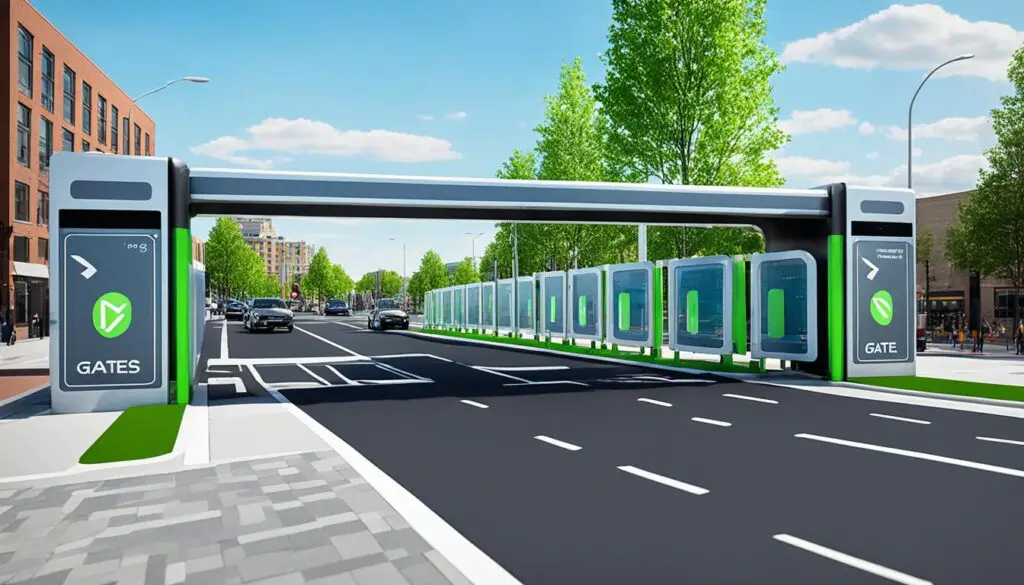
Sustainable Driving: Eco-Friendly Automotive Materials Unveiled
As concerns about the environment and sustainability continue to grow, the automotive industry is taking steps towards a greener future. The integration of eco-friendly materials in automotive manufacturing is gaining momentum, paving the way for sustainable driving and infrastructure.
One of the key areas of focus is the use of eco-friendly automotive materials that are both environmentally conscious and technologically advanced. These materials aim to reduce the carbon footprint of vehicles and promote a more sustainable transportation system.
Construction fabrics, such as needle-punched nonwovens, are gaining popularity due to their eco-friendly features. These fabrics are increasingly being used in applications like tensile structures and canopies, contributing to sustainable building practices. Additionally, the adoption of speed gates, which are access control solutions, is playing a vital role in sustainable infrastructure projects.
By incorporating these eco-friendly automotive materials and technologies, the industry is driving towards a future where sustainable driving and infrastructure are the norm.
Key Takeaways:
- The automotive industry is increasingly focusing on eco-friendly materials for a more sustainable future.
- Construction fabrics like needle-punched nonwovens are being used in sustainable building practices.
- Speed gates play a vital role in sustainable infrastructure projects.
- Integrating eco-friendly materials and technologies promotes sustainable driving.
- The industry aims to reduce its carbon footprint and create a greener transportation system.
The Growing Adoption of Eco-Friendly Automotive Materials
In the automotive industry, there is a growing move towards carbon neutrality and the use of eco-friendly materials. Original equipment manufacturers (OEMs) aim to reach net zero by 2050, but incoming regulatory pressure on emissions will require them to improve current emissions reporting and develop more pragmatic decarbonization strategies.
The integration of eco-friendly materials, such as recycled materials or natural fibers, in automotive manufacturing is seen as a more sustainable option compared to traditional materials like steel and concrete. Not only do these materials help reduce the carbon footprint of vehicles, but they also offer additional advantages. For instance, the use of sustainable building materials in automotive interiors can enhance air quality and reduce the amount of harmful chemicals in the cabin.
The Benefits of Eco-Friendly Automotive Materials
- Lower carbon emissions: By using eco-friendly materials, automotive manufacturers can significantly reduce the carbon emissions associated with the production and use of vehicles. This contributes to the overall goal of achieving carbon neutrality in the industry.
- Resource conservation: Eco-friendly materials often utilize recycled or renewable resources, reducing the dependence on finite resources like fossil fuels. This promotes sustainable practices and a more circular economy.
- Improved energy efficiency: Some eco-friendly materials offer better insulation properties, improving the energy efficiency of vehicles. This ultimately leads to reduced fuel consumption and lower greenhouse gas emissions.
- Enhanced recyclability: Eco-friendly materials are designed to be easily recyclable, reducing waste and minimizing the environmental impact at the end of a vehicle’s lifecycle.
The automotive industry’s commitment to eco-friendly materials is not only driven by environmental concerns but also by shifting consumer preferences. As more individuals become aware of the impact of their choices on the planet, there is an increasing demand for greener and more sustainable products.
“The integration of eco-friendly materials in automotive manufacturing is a crucial step towards achieving carbon neutrality and ensuring a sustainable future for the industry.” – Automotive expert
By leveraging sustainable building materials and embracing eco-friendly practices, the automotive industry can pave the way towards a greener transportation system. This not only benefits the environment but also creates opportunities for innovation and economic growth.

Through continued research and development, automotive manufacturers can further optimize the use of eco-friendly materials in vehicle production. By prioritizing sustainability, the industry can accelerate the transition to a carbon-neutral future and contribute to a cleaner and healthier planet.
The Role of Speed Gates in Sustainable Infrastructure
In today’s world, creating sustainable infrastructure is of utmost importance. Speed gates, a type of access control solution, are playing a vital role in achieving this goal. Speed gates are used in various sectors, including commercial, residential, and public infrastructure, to enhance security and efficiency while maintaining a sustainable environment.
Technological advancements have revolutionized speed gates, making them more energy-efficient and environmentally friendly. The use of biometric authentication ensures only authorized individuals can access specific areas, reducing the risk of unauthorized entry and improving security overall. Additionally, energy-efficient technologies in speed gates contribute to minimizing the carbon footprint of infrastructure projects.
“The integration of eco-friendly technologies in speed gates positively impacts the sustainability of infrastructure projects.” – Industry Expert
Aside from the environmental benefits, the adoption of speed gates in sustainable infrastructure projects is driven by heightened security concerns and the need for enhanced operational efficiency. By efficiently managing and controlling the flow of individuals, speed gates contribute to the smooth operation of infrastructure facilities while ensuring the safety of occupants and minimizing congestion.

Whether it’s managing crowd movement in transportation hubs, securing commercial buildings, or enhancing residential safety, speed gates offer an effective solution that aligns with sustainable infrastructure objectives. Their integration brings together advanced security features, energy efficiency, and ease of use, making them an essential component of sustainable infrastructure projects.
Advantages of Speed Gates in Sustainable Infrastructure:
- Enhanced security: Speed gates provide controlled access, minimizing the risk of unauthorized entry and enhancing overall security.
- Energy efficiency: Incorporating energy-efficient technologies reduces the environmental impact of infrastructure projects.
- Operational efficiency: Speed gates streamline the flow of individuals, improving efficiency and reducing congestion.
- Sustainability: By incorporating eco-friendly features, speed gates contribute to the overall sustainability of infrastructure projects.
| Advantages | Description |
|---|---|
| Enhanced security | Speed gates provide controlled access, minimizing the risk of unauthorized entry and enhancing overall security. |
| Energy efficiency | Incorporating energy-efficient technologies reduces the environmental impact of infrastructure projects. |
| Operational efficiency | Speed gates streamline the flow of individuals, improving efficiency and reducing congestion. |
| Sustainability | By incorporating eco-friendly features, speed gates contribute to the overall sustainability of infrastructure projects. |
Overall, speed gates are an essential component of sustainable infrastructure, bringing together security, energy efficiency, and operational effectiveness. As the demand for sustainable solutions continues to grow, speed gates will play an increasingly important role in constructing a greener and more secure future.
Conclusion
The automotive industry is driving towards a sustainable future by embracing the principles of carbon neutrality and eco-friendly materials. By integrating sustainable driving practices and adopting eco-friendly automotive materials such as construction fabrics and speed gates, the industry is paving the way for a greener and more environmentally friendly transportation system.
The use of construction fabrics, such as needle-punched nonwovens, in applications like tensile structures and canopies showcases their eco-friendly features and their potential to contribute to the sustainability goals of the automotive industry.
Additionally, speed gates, with their advanced technologies like biometric authentication and energy-efficient systems, are playing a crucial role in sustainable infrastructure projects. These gate solutions provide heightened security, enhance operational efficiency, and align with the industry’s commitment to eco-friendly practices.
By prioritizing the integration of eco-friendly materials and technologies, as well as improving current emissions reporting, the automotive industry is spearheading a positive transformation in transportation. This commitment to sustainable driving and infrastructure not only ensures a cleaner and healthier environment for future generations but also establishes a foundation for a more sustainable and efficient transportation system.
FAQ
How are eco-friendly automotive materials contributing to sustainable driving?
Eco-friendly automotive materials, such as construction fabrics and speed gates, play a crucial role in promoting sustainable driving. These materials offer eco-friendly features and are considered more sustainable options compared to traditional materials like steel and concrete.
What are the benefits of integrating eco-friendly solutions in the automotive industry?
By integrating eco-friendly solutions, the automotive industry can drive the transition to a greener and more sustainable transportation system. These solutions help reduce carbon emissions, improve energy efficiency, and contribute to the industry’s goal of achieving carbon neutrality.
What is the significance of speed gates in sustainable infrastructure projects?
Speed gates, which are access control solutions, play a vital role in sustainable infrastructure projects. These systems incorporate technological advancements such as biometric authentication and energy-efficient technologies. They enhance security, improve operational efficiency, and contribute to the overall sustainability of infrastructure.
Source Links
- https://www.fmiblog.com/2024/03/01/global-construction-fabric-industry-set-to-soar-fueling-steady-growth-trends-and-anticipated-us-18-0-billion-by-2034/
- https://www.just-auto.com/news/net-zero-trek-ev-data-wanted-supply-chain-challenge-the-week/
- https://www.fmiblog.com/2024/03/01/competetive-landscape-of-speed-gate-market/
